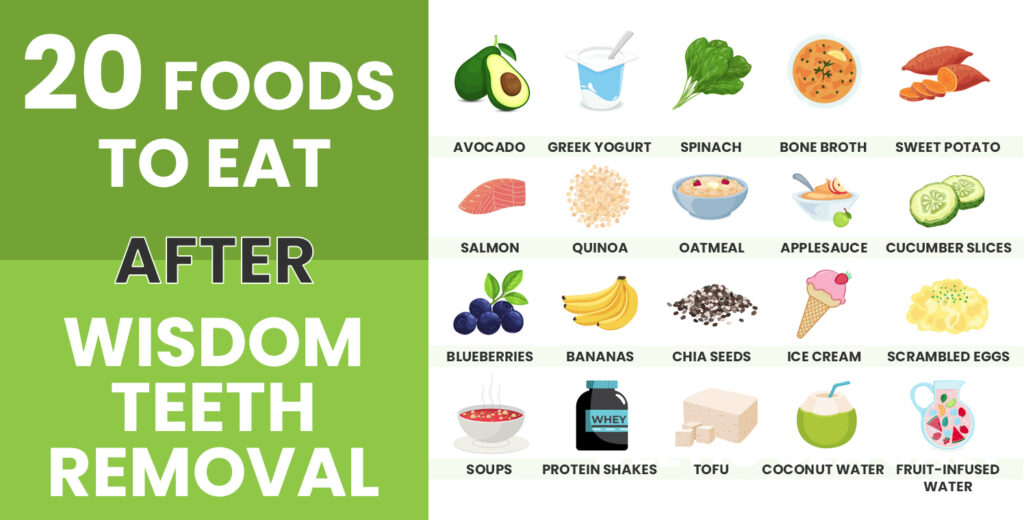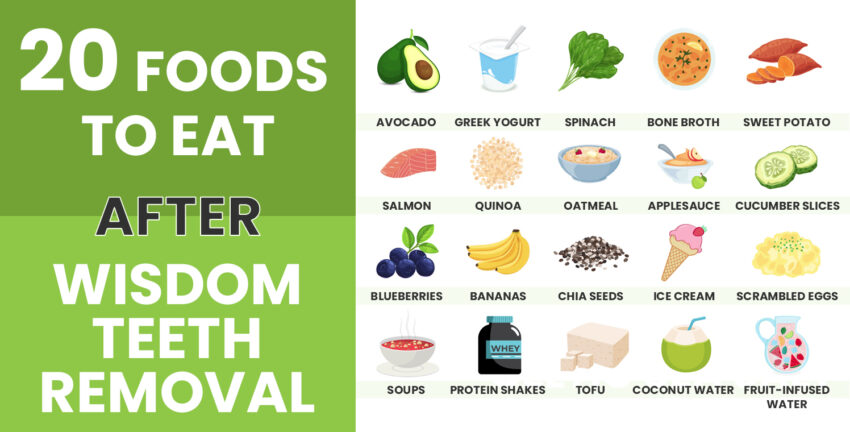
The Ultimate Guide to the Best Foods After Tooth Extraction
Undergoing a tooth extraction can be a daunting experience. The recovery period is crucial for proper healing, and one of the most important aspects of recovery is your diet. Choosing the best foods after tooth extraction can significantly impact your comfort and the speed of your healing process. This comprehensive guide will provide you with everything you need to know about what to eat and what to avoid after your procedure, ensuring a smooth and comfortable recovery. This article aims to provide clear, concise, and actionable advice on navigating your diet in the days following your extraction.
Why Your Diet Matters After Tooth Extraction
After a tooth extraction, your mouth is in a sensitive state. A blood clot forms in the socket where the tooth was removed, acting as a protective barrier for the underlying bone and nerves. Disrupting this clot can lead to a painful condition called dry socket. Certain foods can irritate the extraction site, introduce bacteria, or require excessive chewing, all of which can hinder the healing process. Therefore, carefully selecting the best foods after tooth extraction is vital.
The First 24 Hours: Focus on Liquids
In the first 24 hours following your tooth extraction, stick to a liquid diet. This minimizes the need for chewing and reduces the risk of disturbing the blood clot. Here are some excellent options:
- Water: Stay hydrated by drinking plenty of water. Avoid using straws, as the sucking motion can dislodge the clot.
- Broth: Chicken broth, vegetable broth, or bone broth are nutritious and easy to consume. Ensure it’s lukewarm, not hot, to prevent irritation.
- Smoothies: Smoothies are a great way to get essential nutrients. Avoid using small seeds (like chia or flax) that could get lodged in the extraction site. Blending fruits like bananas, berries (without seeds), and yogurt provides a balanced and soothing meal.
- Apple Sauce: A smooth, unsweetened apple sauce can be a comforting and easy-to-swallow option.
- Jell-O: Plain Jell-O is a gentle option that requires no chewing.
Days 2-7: Gradually Introduce Soft Foods
As you progress through your recovery, you can gradually introduce soft foods that require minimal chewing. Remember to listen to your body and avoid anything that causes pain or discomfort. Continuing to prioritize the best foods after tooth extraction is key during this phase.
Excellent Soft Food Choices
- Mashed Potatoes: Creamy mashed potatoes are a comforting and easily digestible option. Avoid adding chunky ingredients or spicy seasonings.
- Yogurt: Yogurt is a good source of protein and calcium, promoting healing. Opt for plain, unsweetened varieties to avoid added sugars.
- Scrambled Eggs: Soft scrambled eggs are a protein-rich option that requires minimal chewing.
- Oatmeal: Cooked oatmeal is a gentle and nutritious choice. Ensure it’s cooled to a comfortable temperature and avoid adding nuts or seeds.
- Avocado: Mashed avocado is a healthy and creamy option packed with healthy fats and nutrients.
- Soft Cooked Pasta: Overcooked pasta with a mild sauce is generally well-tolerated.
- Well-Cooked Fish: Flaky, well-cooked fish like cod or salmon is a good source of protein and omega-3 fatty acids, which can aid in healing. Make sure there are no bones!
- Tofu: Soft tofu can be easily incorporated into smoothies or mashed on its own.
Foods to Avoid After Tooth Extraction
Certain foods can hinder the healing process and should be avoided in the days following your tooth extraction. Knowing what to avoid is just as important as knowing the best foods after tooth extraction.
- Hard, Crunchy Foods: Chips, nuts, seeds, popcorn, and pretzels can irritate the extraction site and dislodge the blood clot.
- Chewy Foods: Steak, jerky, and gummy candies require excessive chewing and can put strain on the healing area.
- Spicy Foods: Spicy foods can irritate the extraction site and cause discomfort.
- Acidic Foods: Citrus fruits, tomatoes, and vinegar can irritate the sensitive tissues.
- Alcohol: Alcohol can interfere with healing and may interact with pain medications.
- Caffeinated Beverages: Caffeine can increase blood pressure, potentially hindering healing.
- Small Grains and Seeds: Rice, quinoa, sesame seeds, and poppy seeds can get lodged in the extraction site and cause irritation or infection.
Tips for Eating Comfortably
Eating after a tooth extraction can be challenging. Here are some tips to make the process more comfortable:
- Eat on the Opposite Side: Chew on the side of your mouth opposite the extraction site to minimize irritation.
- Take Small Bites: Smaller bites are easier to manage and require less chewing.
- Rinse Gently: After eating, gently rinse your mouth with warm salt water to remove food particles. Avoid vigorous swishing, which can dislodge the clot.
- Maintain Good Oral Hygiene: Continue brushing your teeth gently, avoiding the extraction site for the first few days.
- Listen to Your Body: If a food causes pain or discomfort, stop eating it.
Hydration is Key
Staying hydrated is crucial for healing. Drink plenty of water throughout the day. Avoid using straws, as the sucking motion can dislodge the blood clot. Sip water gently from a glass. Staying properly hydrated aids the healing process and helps prevent dry mouth, which can be uncomfortable. Dehydration can also slow down the healing process, making it even more crucial to maintain adequate fluid intake.
Managing Pain and Discomfort
Pain and discomfort are common after a tooth extraction. Follow your dentist’s instructions for pain management. Over-the-counter pain relievers like ibuprofen or acetaminophen can help. Applying ice packs to your face can also reduce swelling and pain. If you experience severe pain or signs of infection (fever, pus), contact your dentist immediately. Remember, choosing the best foods after tooth extraction is just one piece of the puzzle; proper pain management is equally important.
What to Do if You Suspect Dry Socket
Dry socket is a painful condition that occurs when the blood clot is dislodged from the extraction site. Symptoms include severe pain that radiates from the extraction site, bad breath, and a foul taste in your mouth. If you suspect you have dry socket, contact your dentist immediately. They can provide treatment to relieve the pain and promote healing. Proper care, including following dietary guidelines for the best foods after tooth extraction, can help prevent dry socket.
Long-Term Considerations
While the initial recovery period is crucial, it’s important to maintain good oral hygiene long-term. Brush and floss regularly, and schedule regular dental checkups. Consider using a soft-bristled toothbrush to avoid irritating the gums. Continuing to make healthy food choices will also benefit your overall oral health. Remember, the best foods after tooth extraction aren’t just for the recovery period; they’re part of a healthy lifestyle.
Sample Meal Plan for the First Week
Here’s a sample meal plan to guide you through the first week after your tooth extraction. Remember to adjust it based on your individual needs and preferences.
- Day 1:
- Breakfast: Smoothie (banana, yogurt, milk)
- Lunch: Chicken broth
- Dinner: Apple sauce
- Snacks: Jell-O, water
- Day 2-3:
- Breakfast: Oatmeal (cooled)
- Lunch: Mashed potatoes
- Dinner: Yogurt
- Snacks: Broth, water
- Day 4-7:
- Breakfast: Scrambled eggs
- Lunch: Soft cooked pasta with mild sauce
- Dinner: Well-cooked fish (cod or salmon)
- Snacks: Avocado, water
Conclusion: Prioritizing Your Recovery
Choosing the best foods after tooth extraction is essential for a smooth and comfortable recovery. By sticking to soft foods, avoiding irritants, and following your dentist’s instructions, you can promote healing and minimize the risk of complications. Remember to stay hydrated, manage pain effectively, and maintain good oral hygiene. With proper care and attention to your diet, you’ll be back to enjoying your favorite foods in no time. Understanding the importance of proper nutrition during this crucial period is key to a successful recovery. So, take the time to plan your meals and snacks accordingly, and don’t hesitate to reach out to your dentist or a registered dietitian for personalized guidance. [See also: Post-Extraction Care Tips] [See also: Managing Pain After Tooth Extraction]
